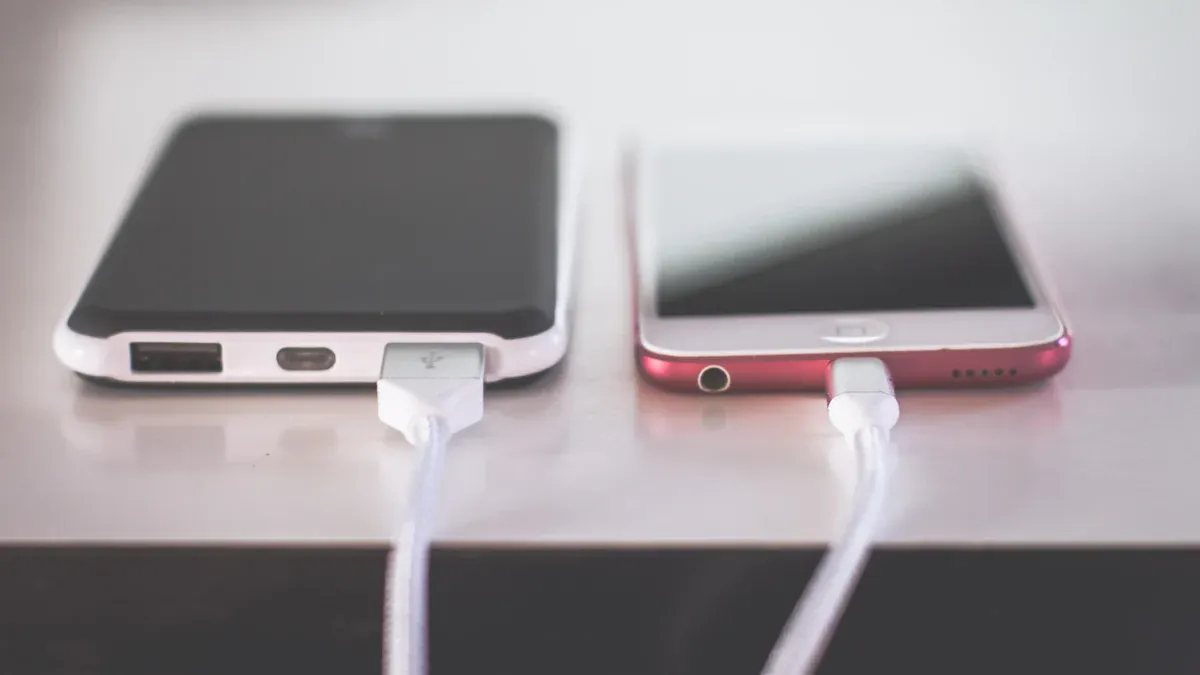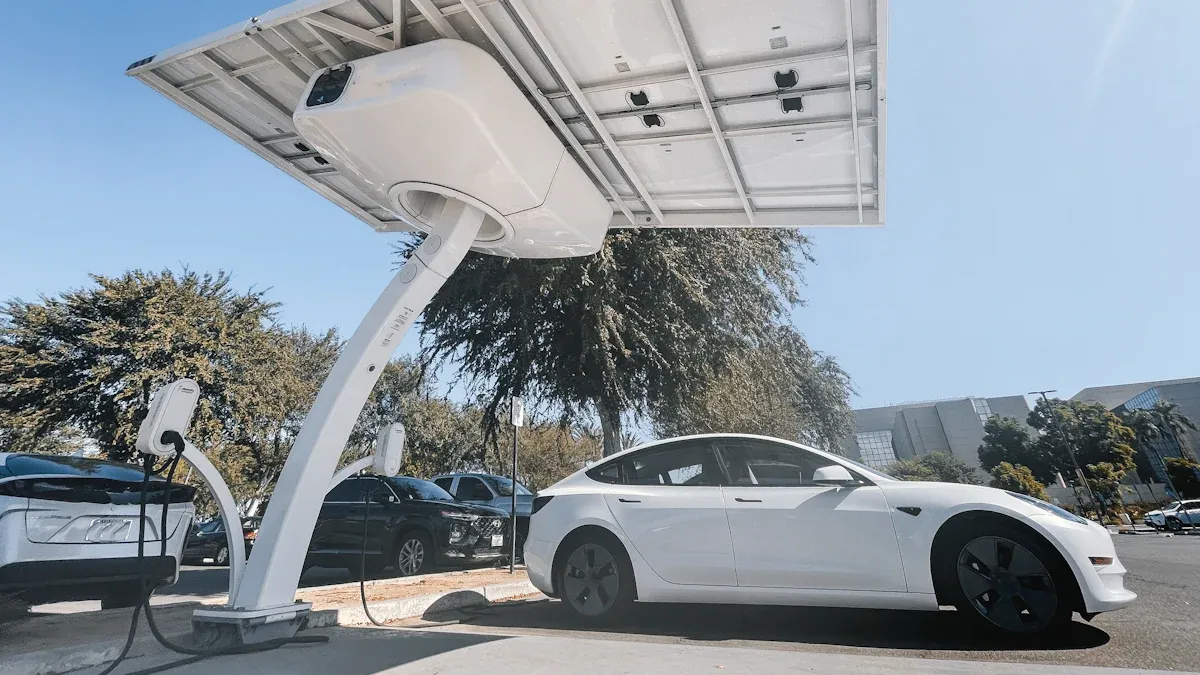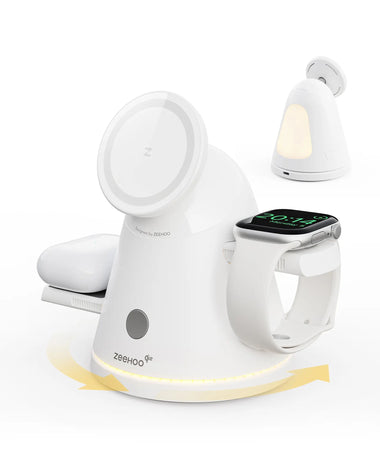You will notice big changes in how you charge your devices in 2025. The wireless charging market around the world will grow a lot. It will reach $37.28 billion, which shows strong growth.
- Market size in 2024: $30.75 billion
- It may reach $172.17 billion by 2032 (CAGR 24.4%)
|
Trend Description |
Significance |
|---|---|
|
Makes power transfer better and wastes less energy. |
|
|
Safety improvements |
Adds foreign object detection and heat control. |
|
Integration into consumer electronics |
Helps more people use it and makes it easier. |
|
Long-range wireless charging |
Is the next big step for charging technology. |
|
Fast charging for electric vehicles |
Focuses on moving energy faster for EVs. |
You can expect wireless chargers to work better, be safer, and be simpler to use. These changes will affect your daily life and what devices you pick.
Key Takeaways
- Wireless charging will get quicker and work better, so you will not have to wait as long for your device to charge. - You should check for the Qi2 logo when you buy chargers to make sure they work with your device and give you faster charging. - Long-range wireless charging will let you charge devices from far away, so it will be easier to charge in places like stores or airports.
Qi2 Wireless Charger Standard
Faster Charging
Qi2 brings a big leap in charging speed. You can now charge your devices at up to 15 watts, which is twice as fast as the old Qi standard for Apple products. This means you spend less time waiting for your phone to power up. The new Magnetic Power Profile (MPP) helps your device line up perfectly with the charger. This perfect alignment cuts down on wasted energy and heat. You get a faster and safer charging experience.
|
Feature |
Qi |
Qi2 |
|---|---|---|
|
Supports Magnetic Charging? |
No |
Yes |
|
Maximum Watts for Apple |
7.5W |
15W |
Device Compatibility
You will see more devices supporting Qi2 in 2025. The Google Pixel 10 series leads the way as one of the first major brands to use this standard. Samsung is also expected to join, but some Galaxy phones may need a magnetic case to work with a Qi2 wireless charger. This growing support means you will have more choices when picking your next phone or accessory.
User Benefits
With Qi2, you enjoy a seamless wireless charging experience. You do not need to worry about plugging in cables. The magnetic attachment keeps your device in the right spot, so you get the best charging speed every time. You can expect less heat and more efficient power transfer, which helps your battery last longer.
Tip: Look for the Qi2 logo when buying your next wireless charger to make sure you get these benefits.
Challenges
Qi2 still faces some hurdles. Wireless charging is less efficient than using a cable, so some energy gets lost as heat. Faster charging speeds can make devices warmer, which may affect battery life. New Qi2 chargers and devices might cost more at first. Not all older devices will work with Qi2, which could make it harder for everyone to switch right away.
Long-Range Wireless Charging
How It Works
Now you can charge your device from far away. Long-range wireless charging uses radio frequency systems and resonant inductive coupling. RF systems send energy with radio waves. Resonant inductive coupling uses coils that match the same frequency. These methods let you use wireless power over longer distances. You do not have to keep your device on a pad anymore.
Real-World Impact
In 2025, you see long-range wireless charging in many places. Homes and offices have smart furniture with charging pads inside. Airports, cafes, and hotels have wireless charging stations for many devices at once. Hospitals and factories use this for medical sensors and robotic tools. Here is a table with some real-life examples:
|
Application Area |
Description |
|---|---|
|
Public and Commercial Spaces |
Wireless charging stations are built into airports, cafes, hotels, and offices. They support many devices and help customers stay connected. |
|
Smart Furniture and Home Integration |
Furniture with charging pads is more common. This helps keep rooms neat and fits smart home trends. |
|
Industrial and Healthcare Applications |
Wireless charging is used for things like medical sensors and robotic tools. This helps keep things clean and working longer. |
Benefits
Wireless power gives you many good things:
- You can charge devices without cables, even from far away.
- Charging is safer because there is less chance of electric shock.
- Your home or office looks cleaner with fewer wires.
- Wireless power helps in electronics, medical devices, and cars.
Limitations
Long-range wireless charging still has some problems. You still need a power outlet for the charger, so it is not totally cable-free. Charging is slower than using wires, and some energy is lost as heat. Devices may need to stay in one spot to charge well. Here is a table with the main problems:
|
Limitation |
Description |
|---|---|
|
Cables aren’t wholly absent |
Wireless charging still needs a power outlet, so it is not fully cable-free. |
|
Overheating risks |
Inductive charging is not as efficient. Some energy is lost as heat during charging. |
|
Low charging speed |
Wireless chargers are usually slower than wired ones because they are less efficient. |
Note: Wireless power and long-range charging will keep getting better as new ideas make charging faster and more efficient.
Multi-Device Charging

Universal Pads
Now you can charge many devices at the same time. Universal pads let you put your phone, smartwatch, and earbuds together. Many new wireless chargers support this idea. You do not need to find a different charger for each gadget. Universal pads help keep your area clean and neat.
|
Device Type |
Charging Capability |
Notes on Compatibility |
|---|---|---|
|
Qi-enabled accessories |
Some chargers may not work with all watches |
|
|
Anker MagGo 3-in-1 Station |
Charges iPhones and Android phones |
Android phones may charge slower than iPhones |
|
Dual/3-in-1 chargers |
Power drops a bit when charging many devices |
You trade some power for charging more things |
Cross-Brand Use
You do not have to worry about which brand you use. The Qi standard is now used by many companies. You can use one pad for lots of different devices. This means you can charge your phone, your friend’s phone, and your smartwatch, even if they are not the same brand. Charging is much easier for everyone.
- The Qi standard works with many brands.
- One pad can charge many Qi-enabled devices.
Benefits
Charging many devices at once helps you in many ways. You save time because you can charge everything together. Your desk or nightstand stays neat with no messy cords. Wireless charging pads last longer than cables, so you do not need to buy new ones often. Safety features stop your devices from overcharging, so you can charge overnight without worry.
Tip: A wireless charger that charges many devices can help you stay neat and ready for your day.
Issues
There are some problems with these pads. Charging many devices at once can make them less efficient and cause more heat. Some pads may not work with every device or may charge slower when used for many gadgets. It is important to control heat and make sure each device charges safely.
|
Challenge |
Description |
|---|---|
|
Efficiency Issues |
Low efficiency wastes power and makes heat, which can stop charging. |
|
Heat Management |
Too much heat can stop charging; good design is needed. |
|
Foreign Object Detection (FOD) |
Pads must find objects that could cause overheating. |
|
Magnetic Field Interference |
Many magnetic fields can make charging unstable. |
|
Specialized Chipsets |
Special chips are needed for free-position charging. |
Wireless Charging for EVs and Robots

EV Integration
In 2025, you will see new ways to charge electric vehicles. Cars can get power while driving on special roads. This is called in-road dynamic wireless charging. It helps your car keep running longer and stops you from worrying about running out of power. Wireless Power Transfer (WPT) lets you charge without plugging in cables. You just park or drive over a pad, and your car starts charging. Engineers work to make these systems cheaper and easier to use. They focus on making coils better and helping cars line up with chargers. These changes help more people use wireless charging for their cars.
- In-road charging gives your car power as you drive.
- WPT makes charging simple and quick.
- Better coil design and alignment help charging work well.
AMR Charging
AMR charging systems are changing a lot. Robots can now charge without touching anything. This means robots do not wear out as fast. Charging starts right away, so robots work more and wait less. These systems help robots in factories and warehouses do their jobs better. Here is a table with the main benefits:
|
Benefit |
Description |
|---|---|
|
Remarkable Energy Utilization |
Efficiency rates reach up to 95%, saving electricity and money. |
|
Instantaneous Energy Supply |
Charging begins immediately, reducing downtime. |
|
Zero Contact: Zero Maintenance |
No physical connections, so less maintenance is needed. |
|
Enhanced Safety |
No wires means fewer hazards in the workspace. |
|
Wider Positioning Tolerance |
Robots can charge from different angles, making operations smoother. |
|
Interoperability |
One system charges different battery types. |
|
Intelligent Data Transfer |
Data moves during charging for better robot management. |
|
Suitable for Outdoor Use |
Sealed systems work well outside, even in wet conditions. |
Market Growth
Wireless charging for EVs and robots is growing fast. The market for wireless EV charging was worth $466 million in 2023. It could grow to $12.4 billion by 2033. The market may go from $0.09 billion in 2025 to $1.12 billion by 2032. This means more people will use wireless charging for cars and robots.
- Plug-in hybrid electric vehicles help the market grow.
- More factories and offices use amr charging to work better.
Challenges
There are still some problems with wireless charging for EVs and robots. Engineers need to fix coil alignment and lower costs. Some systems charge slower than cables. Cities and factories need new equipment for wireless charging. Asia Pacific leads the way, with China, Japan, South Korea, and India building new systems. These countries help set rules and grow the wireless charging market.
Tip: Look for new charging stations and smart roads in your city as wireless charging gets bigger.
Emerging Trends in Wireless Charging
Energy Harvesting
New wireless charging systems use energy from the environment. Devices can get power from light, sound, or radio waves. This helps make batteryless systems, so there is less battery waste. Wireless Power Transfer gives a steady way to charge phones and electric cars. Some systems use RF signals to send power and information together. These new ideas make charging easier and safer.
- Devices use energy from light and sound.
- Batteryless systems help keep the planet clean.
- Wireless Power Transfer works with many devices.
Sustainability
Next-generation wireless charging helps you live in a greener way. You do not need as many cables, so there is less trash. Charging electric vehicles with wireless systems can use solar or wind power. This lowers carbon emissions. New charging pads work better, so less energy is wasted. These changes help homes and businesses charge smarter.
- Wireless charging cuts down on cable trash.
- EV charging can use solar or wind energy.
- Better systems save more energy.
Market Outlook
Wireless charging technology will grow a lot soon. The global market may reach USD 10.73 billion in 2025. Experts think it will grow fast and hit USD 45.44 billion by 2032. Asia Pacific will be the top market, then North America and Europe. You will see more wireless charging at home, work, and in public places.
- Market size in 2025: USD 10.73 billion
- Projected size in 2032: USD 45.44 billion
- Asia Pacific is growing fastest
Barriers
There are some problems with new wireless charging systems. The table below shows the main barriers:
|
Barrier Type |
Description |
|---|---|
|
Financial Constraints |
Not enough money for new ideas |
|
Technical Hurdles |
Hard to add new technology |
|
Environmental Concerns |
Problems with keeping things green |
Better answers are needed to help wireless charging work for everyone.
Wireless charging will change how you use devices in 2025. You can charge things faster and easier than before. Electric cars will charge without cables, making it simple. Smart furniture lets you charge at home with no mess. Look at this table to see how these trends help you:
|
Trend |
Impact on You |
|---|---|
|
Fast Charging |
You wait less and it is easier |
|
EV Charging |
Charging your car is quick and simple |
|
Smart Furniture |
Your home stays neat and charging is easy |
|
Over-the-Air Charging |
You power devices without touching them |
Keep an eye out for new wireless charging in cars and public places. Medical devices will also use better wireless chargers soon. Chargers will get faster, smarter, and work better for you.
FAQ
What devices work with Qi2 wireless chargers?
Qi2 chargers work with many new smartphones, earbuds, and smartwatches. You should look for the Qi2 logo on your device or charger to make sure they match.
Is long-range wireless charging safe for daily use?
Long-range wireless charging is safe to use every day. These systems have strong safety rules and special features to stop overheating.
Can I charge different brands on one wireless pad?
You can charge different brands if they use the same wireless charging standard. Check for Qi or Qi2 support to get the best results.






